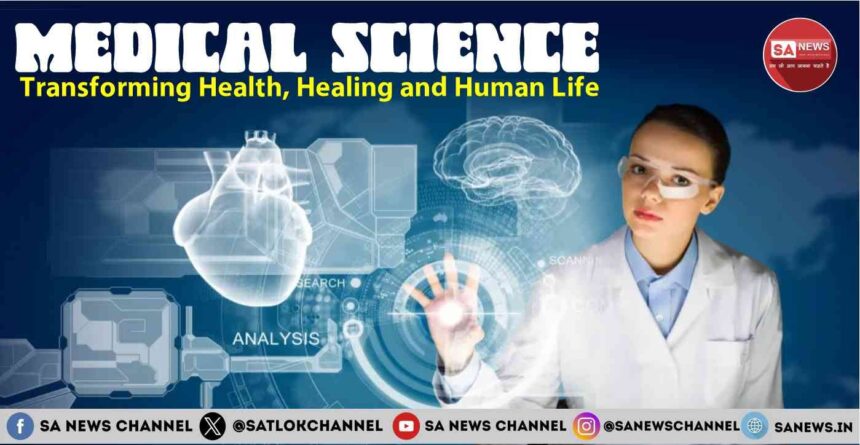Medical science is one of humanity’s greatest accomplishments — a field that combines extensive scientific knowledge with advanced technology to enhance health and save lives. From fighting infectious diseases to developing treatments for cancer, heart issues, and genetic disorders, medical science is constantly advancing at a remarkable speed.
- Evolution of Medical Science: From Ancient Healing to Modern Innovation
- Ancient Roots
- Scientific Revolution (16th–18th Century)
- Modern Era (19th–20th Century)
- Contemporary Advances (21st Century)
- Evolution of Medical Science: India’s Enduring Legacy and Global Impact
- Ancient Roots: India’s Pioneering Contributions
- Scientific Revolution: Foundations in Rational Inquiry
- Modern Era: Bridging Tradition and Technology
- Contemporary Advances: India on the Global Medical Map
- Major Branches of Medical Science
- Medical Science in Everyday Life
- Role of Technology in Medical Science
- Breakthroughs in Medical Science
- Importance of Public Health
- Medical Ethics and Challenges
- 1. Patient Rights and Consent
- 2. Confidentiality
- 3. Accessibility
- 4. Over-Reliance on Technology
- 5. Bioethics
- Future of Medical Science
- 1. Personalized Medicine
- 2. Artificial Intelligence (AI)
- 3. Regenerative Medicine
- 4. Global Collaboration
- 5. Affordable and Accessible Healthcare
- Conclusion
- Sant Rampal Ji Maharaj’s Teachings: The Spiritual Aspect of Health and Healing
It not only aids in diagnosing and treating diseases but also plays an essential role in prevention, rehabilitation, and improving overall quality of life. As we enter a new era characterized by breakthroughs such as personalized medicine, biotechnology, and AI in healthcare, medical science promises a healthier and longer life for everyone.
In this blog, we will look at how far we have come, the current innovations influencing modern medicine, and what the future may bring for this continually evolving field.
Evolution of Medical Science: From Ancient Healing to Modern Innovation

Ancient Roots
The roots of medical science go back to the first civilizations, where healing involved observation, spirituality, and natural remedies.
- In ancient Egypt, doctors performed basic surgeries, set broken bones, and utilized herbs, minerals, and honey for healing. They gained an early understanding of anatomy through the process of mummification.
- Traditional Chinese Medicine (TCM) aimed to restore balance in the body through acupuncture, herbal treatments, and the idea of Qi (vital energy).
- In ancient Greece, Hippocrates brought a systematic and rational method to medicine. His idea that diseases had natural origins established the basis for clinical observation and diagnosis. The Hippocratic Oath became a lasting representation of medical ethics.
Scientific Revolution (16th–18th Century)

The Renaissance and Enlightenment eras were pivotal in medical history, shifting from superstition to scientific inquiry based on evidence.
- Andreas Vesalius conducted human dissections and published precise anatomical illustrations that rectified many errors found in ancient writings.
- William Harvey’s 1628 discovery of blood circulation transformed the comprehension of cardiovascular physiology.
- Antonie van Leeuwenhoek’s invention of the microscope revealed a hidden world of microbes, establishing the foundation for microbiology.
- Medical schools started to adopt scientific methods, anatomy labs, and clinical practice, resulting in a more organized training process for physicians.
Modern Era (19th–20th Century)
With the growth of industrialization and scientific research, medicine progressed quickly in theory, practice, and technology.
- In 1796, Edward Jenner developed the smallpox vaccine, which was a major step forward in preventing diseases.
- Louis Pasteur and Robert Koch established the germ theory of disease, showing that germs cause infections.
- Alexander Fleming’s discovery of penicillin in 1928 brought about a significant shift in how bacterial infections are treated.
- Advancements like anesthesia, X-ray imaging, blood transfusion, and antiseptic surgery greatly enhanced patient outcomes.
- Hospitals transformed into scientific institutions, and public health efforts lowered mortality rates by enhancing sanitation, nutrition, and disease management.
Contemporary Advances (21st Century)

Modern medical science is now closely linked with technology, data, and personalized care.
- Genomic medicine enables doctors to customize treatments according to a person’s genetic profile, enhancing the effectiveness of therapies.
- Artificial Intelligence (AI) aids in early disease detection, predictive analysis, robotic surgery, and efficient healthcare delivery.
- Telemedicine has broadened access to medical services, particularly in remote regions, through video consultations and digital prescriptions.
- Regenerative medicine, which utilizes stem cells and bioprinting, offers potential solutions for damaged organs and chronic diseases.
- The swift advancement and implementation of mRNA vaccines, particularly during the COVID-19 pandemic, showcased the strength of modern biotechnology and global scientific cooperation.
Evolution of Medical Science: India’s Enduring Legacy and Global Impact

Ancient Roots: India’s Pioneering Contributions
India is home to some of the oldest and most important contributions to medical science globally.
- The Ayurvedic system, documented more than 3,000 years ago in texts such as the Charaka Samhita and Sushruta Samhita, laid a strong foundation for holistic medicine.
- Charaka, recognized as the father of Indian medicine, emphasized the need for balance among the three doshas—Vata, Pitta, and Kapha—and presented concepts related to digestion, immunity, and mental well-being.
- Sushruta, recognized as the father of surgery, detailed more than 300 surgical procedures, 120 surgical instruments, and methods such as plastic surgery and cataract removal, long before similar developments occurred in the West.
- Indian medicine encouraged preventive care through daily and seasonal practices, dietary recommendations, yoga, and detox therapies, many of which are now acknowledged worldwide for their effectiveness.
- The idea of hospitals, ethics in patient care, and even early types of anesthesia were investigated in ancient India, demonstrating a well-developed public health system.
Scientific Revolution: Foundations in Rational Inquiry
During the scientific revolution in Europe from the 16th to the 18th centuries, India was busy enhancing its medical knowledge through different scholarly traditions.
- Indian scholars not only preserved classical Ayurvedic texts but also integrated aspects of Unani medicine that came through cultural exchanges.
- Institutions such as Nalanda and Takshashila were famous for both spiritual and medical education, drawing scholars from all over Asia.
- Even though colonial rule interrupted local systems, Indian medical knowledge impacted global understanding through translated texts and traveling doctors.
Modern Era: Bridging Tradition and Technology
In the 19th and 20th centuries, India was actively involved in global medical advancements while also working to protect and revive its traditional systems.
- The merging of Ayurveda with modern medicine started during the nationalist movements, with the goal of decolonizing healthcare and boosting confidence in Indian practices.
- Institutions such as the All India Institute of Medical Sciences (AIIMS) and Banaras Hindu University emerged as leading centers for medical education and research.
- Indian scientists played a key role in identifying diseases like Kala-azar and cholera, and they also created affordable diagnostics and treatments tailored to the needs of rural healthcare.
- After gaining independence, India achieved significant progress in public health, including the elimination of smallpox and polio, large-scale vaccination campaigns, and the establishment of generic pharmaceutical companies.
Contemporary Advances: India on the Global Medical Map
Currently, India is leading in global medical science by combining traditional knowledge with modern technology.
- The nation is a top player in pharmaceutical manufacturing, sending affordable medicines and vaccines to more than 150 countries.
- Indian firms were essential in creating COVID-19 vaccines and distributing them worldwide through programs like Vaccine Maitri.
- Innovations in biotechnology, genomics, telemedicine, and AI-driven diagnostics are being propelled by Indian research organizations and startups.
- India’s Ministry of AYUSH is actively promoting the evidence-based application of Ayurved, Yoga, Unani, Siddha, and Homeopathy, enhancing integrative healthcare.
- Indian physicians and healthcare professionals make up a large portion of the global medical workforce, aiding international healthcare systems, research, and medical training
Major Branches of Medical Science

1. Anatomy and Physiology
These two interconnected areas are fundamental to medical education.
- Anatomy involves examining the structure and arrangement of the human body—its organs, tissues, and systems.
- Physiology looks at how these body components work both separately and together.
Grasping these topics is crucial for identifying health problems and carrying out medical tasks correctly.
2. Pathology
Pathology is the scientific study of diseases, including their origins, development, structural changes, and effects on the body.
- It includes the examination of tissues, organs, blood, and other bodily fluids to identify abnormalities.
- It is essential for diagnosis, treatment planning, and forensic investigations.
3. Pharmacology
Pharmacology studies the effects of drugs on the human body and the body’s reactions to them.
- It covers drug composition, therapeutic applications, mechanisms of action, and side effects.
- This is an essential field for creating new medications and ensuring treatments are safe and effective.
4. Microbiology
Microbiology is the study of microorganisms—bacteria, viruses, fungi, and protozoa—and their impact on health.
- It helps understand the causes of infections, vaccine development, and antibiotic resistance.
- Crucial in diagnosing infectious diseases and maintaining hospital hygiene.
5. Genetics
Genetics studies heredity, DNA, and the impact of genes on traits and diseases.
- It supports genetic counseling, gene therapy, and personalized medicine.
- It aids in recognizing inherited conditions and risks, leading to preventive and targeted healthcare.
6. Surgery
Surgery includes physical methods to address injuries, eliminate unhealthy tissues, or fix deformities.
- It varies from simple procedures to intricate operations such as organ transplants and neurosurgery.
- Contemporary surgery frequently employs robotics, imaging technologies, and minimally invasive methods for improved results.
7. Psychiatry
Psychiatry aims to recognize, address, and avert mental, emotional, and behavioral problems.
- It covers conditions such as depression, anxiety, schizophrenia, and bipolar disorder.
- It includes the use of medication and therapy to enhance mental health.
Medical Science in Everyday Life

Medical science extends far beyond clinics and hospitals—it plays a vital role in maintaining health, preventing diseases, and improving quality of life in daily routines.
Also Read: Nanotechnology: The Science Of Atomic Manipulation
Everyday Applications:
- Vaccination: Protects individuals and communities from infectious diseases such as measles, polio, and COVID-19.
- Diagnostic Tests: Help in early detection of conditions like cancer, diabetes, and infections, enabling timely treatment.
- Medicines: From common cold to chronic illnesses, medications help manage fever, infections, hypertension, diabetes, and more.
- Hygiene and Sanitation: Scientific understanding promotes handwashing, safe drinking water, and waste management to prevent the spread of diseases.
- Mental Health Awareness: Knowledge in psychology and psychiatry improves emotional well-being, reduces stigma, and supports stress and anxiety management.
Role of Technology in Medical Science
Modern medical science is powered by technology, making diagnosis, treatment, and data management more precise, efficient, and accessible.

Diagnostic Tools:
- MRI and CT Scans: Generate detailed 3D images of internal organs, bones, and tissues for accurate diagnosis.
- Ultrasound: Safe imaging technique used to monitor pregnancies and diagnose abdominal and cardiac issues.
- Blood Tests: Reveal infections, hormone levels, liver and kidney functions, and nutritional deficiencies.
Treatment Tools:
- Lasers: Used in surgeries, especially for vision correction, dermatology, and tumor removal.
- Pacemakers: Devices that are placed inside patients to control irregular heartbeats.
- Robotic Surgery: Minimally invasive surgeries performed with high precision, reducing recovery time and complications.
Information Technology:
- Telemedicine: Enables patients to consult doctors remotely via video or phone, improving access in rural and remote areas.
- Electronic Health Records (EHRs): Secure digital records of patient histories, enhancing coordination and efficiency.
- AI Diagnostics: Artificial Intelligence aids in detecting diseases like cancer or diabetic retinopathy with higher speed and accuracy.
Breakthroughs in Medical Science
Medical science continues to achieve remarkable progress, offering new hope in the fight against life-threatening diseases.

Key Innovations:
- Vaccination: Diseases like smallpox have been eradicated, while others like polio and measles are under control due to global immunization programs.
- Antibiotics: The discovery of penicillin revolutionized treatment for bacterial infections and saved millions of lives.
- Organ Transplants: Lifesaving procedures like kidney, liver, and heart transplants are now routine, giving patients a second chance at life.
- Stem Cell Therapy: Offers potential to regenerate tissues and treat degenerative diseases like Parkinson’s, spinal cord injuries, and certain types of diabetes.
- Gene Therapy: Replaces or repairs faulty genes to treat inherited disorders such as SCID (Severe Combined Immunodeficiency) and thalassemia.
- mRNA Vaccines: A new generation of vaccines, like those used in the COVID-19 pandemic, teach the immune system how to fight specific viruses more effectively.
Importance of Public Health
Public health plays a critical role in enhancing the quality of life by focusing on prevention, health promotion, and community well-being. It shifts the focus from treating illness to preventing it, benefiting society as a whole.
1. Preventive Care
Encourages individuals to undergo regular health checkups, vaccinations, and screenings for early detection of diseases.
- Reduces the burden on hospitals
- Detects illnesses at an early, treatable stage
- Promotes proactive health habits
2. Nutrition and Lifestyle
Highlights the importance of a balanced diet, physical activity, and mental well-being to prevent lifestyle-related disorders.
- Reduces risk of obesity, diabetes, and heart disease
- Supports emotional and psychological health
- Promotes longevity and productivity
3. Disease Control
Government programs and health agencies implement measures to prevent and contain diseases.
- Immunization drives, sanitation campaigns, and vector control are key tools
- Helps manage epidemics and pandemics
- Protects vulnerable populations, especially children and the elderly
4. Health Education
Raises awareness on a wide range of issues including hygiene, reproductive health, nutrition, substance abuse, and mental health.
- Empowers communities to make informed decisions
- Reduces stigma around sensitive health topics
- Promotes safe practices and responsible behavior
Medical Ethics and Challenges

As medical science advances, it faces complex ethical questions. Medical ethics ensures that healthcare remains humane, just, and accountable.
1. Patient Rights and Consent
Patients have the right to be fully informed about their condition and treatment options.
- Informed consent is essential before any medical procedure
- Respects patient autonomy and dignity
2. Confidentiality
Healthcare professionals are obligated to keep patient information private and secure.
- Builds trust between doctors and patients
- Protects sensitive data from misuse
3. Accessibility
Every individual, regardless of economic status, gender, or geography, deserves access to quality healthcare.
- Addresses healthcare inequalities
- Promotes social justice and inclusivity
4. Over-Reliance on Technology
While medical technology enhances accuracy, it cannot replace human expertise.
- Machines can fail or misinterpret data
- Ethical dilemmas can occur when decisions are made only by algorithms
5. Bioethics
Scientific advances raise questions about morality and limits.
- Issues like cloning, gene editing, assisted reproduction, and euthanasia require ethical guidance
- Balances innovation with respect for human life and dignity
Future of Medical Science
The future of medical science is being shaped by rapid technological innovation, deeper biological understanding, and a global commitment to equitable healthcare. These advancements promise to revolutionize the way diseases are diagnosed, treated, and prevented.

1. Personalized Medicine
Personalized or precision medicine involves tailoring healthcare to an individual’s genetic profile, lifestyle, and environmental factors.
- Enables more effective treatments with fewer side effects
- Helps identify disease risk before symptoms appear
- Useful in treating conditions like cancer, diabetes, and rare genetic disorders
2. Artificial Intelligence (AI)
AI is expected to become a powerful tool in modern medicine, assisting doctors and researchers in various areas.
- Diagnostic AI systems can analyze scans and reports faster and more accurately
- Robotic-assisted surgeries enhance precision and reduce recovery time
- AI-driven drug discovery can accelerate the development of new treatments by simulating chemical interactions
3. Regenerative Medicine
This field aims to repair or replace damaged organs and tissues using stem cells, biomaterials, and tissue engineering.
- Offers hope for treating conditions like spinal cord injuries, heart failure, and Parkinson’s disease
- Could eventually reduce the need for organ transplants
- Studies are continuing to restore skin, bones, nerves, and even whole organs
4. Global Collaboration
Increased collaboration among nations, scientists, and healthcare institutions is strengthening global health systems.
- Shared research on pandemics, climate-related health issues, and emerging diseases leads to faster solutions
- Open-access data, joint clinical trials, and digital platforms are improving health response coordination worldwide
- Organizations like WHO and GAVI are playing central roles in promoting health equity
5. Affordable and Accessible Healthcare
Future innovations aim to make healthcare more inclusive, cost-effective, and available to underserved populations.
- Low-cost diagnostic tools and mobile health apps are reaching rural areas
- Generic drug manufacturing is helping reduce the cost of essential medicines
- Telemedicine, AI chatbots, and wearable devices are making healthcare more accessible for all
Conclusion
Medical science is one of humanity’s greatest achievements. It has turned deadly diseases into manageable ones, enabled people to live longer, and offered hope where there was none. As it continues to evolve with technology, research, and ethics, medical science holds the promise of a healthier, safer, and more compassionate world.
Understanding medical science is not just for doctors; it empowers everyone to live better, make informed choices, and contribute to a healthier society. Let us respect and support the progress of medical science, while also using it wisely, ethically, and for the good of all humanity.
Sant Rampal Ji Maharaj’s Teachings: The Spiritual Aspect of Health and Healing
Medical Science Addresses the Body, Spiritual Wisdom Heals the Soul
Sant Rampal Ji Maharaj explains that although modern medical science has made great strides in identifying and treating physical ailments, genuine and enduring healing can only be achieved through spiritual understanding.
He clarifies that real health encompasses not just the body, but also mental tranquility and spiritual cleanliness. Many health issues, particularly chronic and untreatable ones, often stem from karmic effects of previous lives. While medications may offer short-term relief, they cannot eradicate the root of suffering linked to past actions.
Naam Diksha: The Path to Karmic Purification
Sant Rampal Ji Maharaj states that only the authentic spiritual journey can clear these karmic obligations. By receiving Naam Diksha (spiritual initiation) from a Complete Saint and engaging in true devotion through mantra chanting and adherence to scriptures, individuals can alleviate both physical and spiritual pain. This practice purifies the soul, fortifies the inner self, and can even lead to healing from ailments that resist medical intervention.
Living Righteously for Lasting Wellness
He highlights the significance of leading a moral and disciplined life—avoiding substances, violence, dishonesty, and unethical actions. Such a lifestyle not only improves physical health but also fosters mental clarity and spiritual development. Preventive health measures in public health closely align with spiritual values of cleanliness, compassion, and self-discipline.
The Union of Science and Spirituality
Sant Rampal Ji Maharaj endorses the application of medical science and encourages individuals to seek treatment when necessary. Nevertheless, he emphasizes that science has its boundaries. While it can heal the body, only spiritual wisdom and devotion to the Supreme God can mend the soul and provide true tranquility. For holistic well-being, He teaches that science and spirituality must work together.








